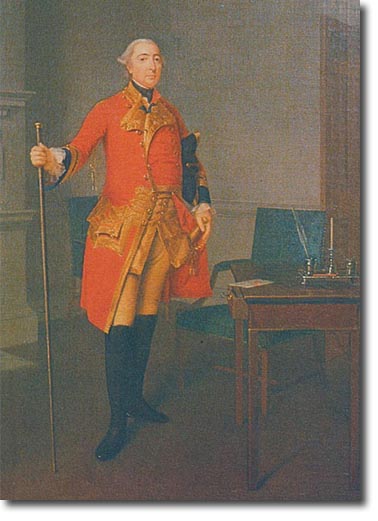|
|

 |
|
Caesar was born around 1709, in London. His family was descended from an Italian doctor called Cesare Adelmare who came to England to attend Queen Mary in 1553. Everyone called him Dr Caesar and his descendants adopted that name. Charles Caesar, father of Julius, was a Jacobite and an MP for Hertford. He was imprisoned in the Tower at one point for conspiring with the King of Sweden to invade England to restore the Stuarts.
Julius Caesar was commissioned as an Ensign into the Coldstream Guards on 18th June 1731. He spent the first 8 years in London. He was promoted to Lieutenant in 1739 and was sent abroad in May 1742 when the Guards Brigade went to the Low Countries. He was wounded at Fontenoy and came home with the regiment in September 1745. Soon after, the Coldstream were sent north to fight the Young Pretender, and Caesar went with them and also had to attend the execution of Jacobites on Tower Hill. His father, who died in 1741, must have been turning in his grave! He was now in command of his own Company which again went abroad and fought at Lauffelt in 1747. Back in England, Julius suffered a period of ill health. He had been a sickly child and as an adult would take to his bed for weeks on end. He managed to stay out of bed long enough for this portrait to be painted by Arthur Devis. He was a Lieutenant-Colonel by this time and appointed 1st Major of the Regiment. As a senior field officer he was on a rosta to do duty as Field-Officer-in-Waiting, responsible for the preservation of good order and discipline near the Royal Person. The portrait shows him holding the rod of office and wearing his dress coat. The year must be around 1755 and there are many aspects of the coat that relate to the dress coat worn in the Foot Guards until 1830. See Officer's Full Dress Coat c1821 Although the lapels are buttoned over, the turned back tops reveal the rich gold lace which is in the form of close-set pointed button loops showing only a little of the blue facing colour. When the lapels are buttoned back the loops would continue below the lapel on the red cloth of the coat, but the 1821 coat is cut away at the waist. The pockets are very similar with a border of wide gold lace all around, forming points at the upper corners. There are three half concealed buttons under the flap. The cuffs have the broad gold lace with a narrower lace above it and three buttons sewn on the blue light between the lace. The collar is covered in gold but the inside indicates that it is of red cloth. His waistcoat is buff, laced with gold and the breeches match. He is wearing black knee boots and there is a hint of silver at his left heel which means he is wearing spurs. We can also see his sword hilt and his gold laced hat. In 1758, Caesar was sent with the 2nd Battalion on a series of raids on the French coast. When he returned home he had domestic problems. He had been having an affair with Peg Woffington, a beautiful actress, since about 1739, but she was very ill and came to live in Caesar's house until her death in March 1760. It is not known if they were secretly married or not. Soon afterwards, he was sent on his last campaign, to protect Hanover from the French. After the battle of Wilhelmstal, the Coldstream Guards had to provide protection for the artillery at Melsungen on the River Fulda. On 7th August 1762, while Julius was making his rounds, visiting the battalions, his horse slipped and he was killed in the fall. He was buried at Elferhausen. |
Armed Forces | Art and Culture | Articles | Biographies | Colonies | Discussion | Glossary | Home | Library | Links | Map Room | Sources and Media | Science and Technology | Search | Student Zone | Timelines | TV & Film | Wargames